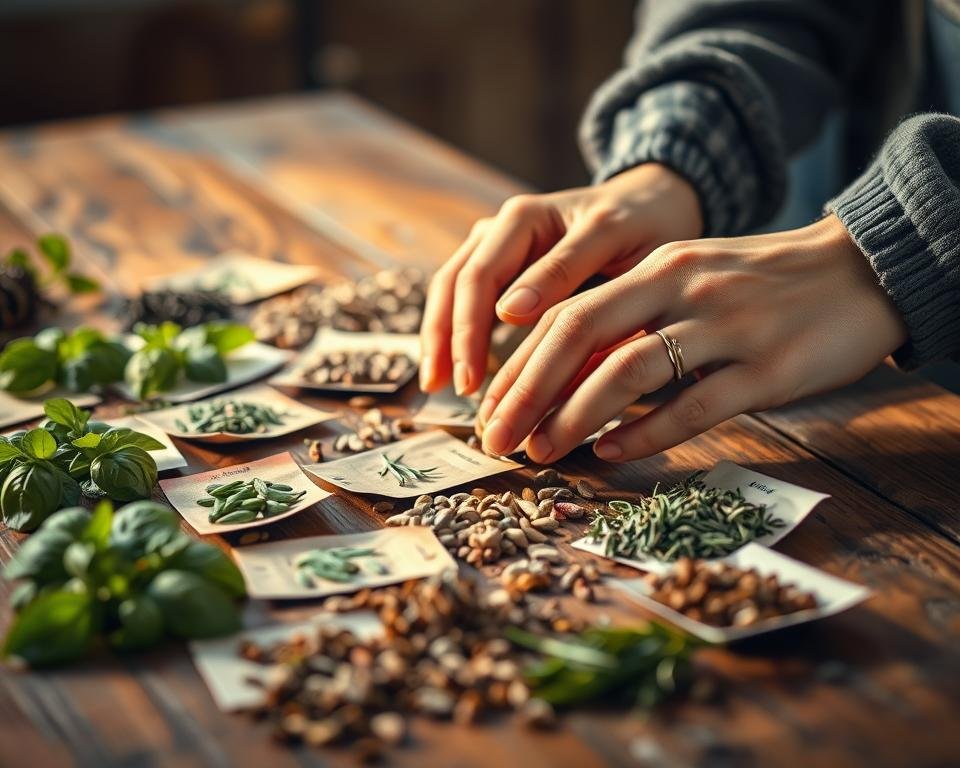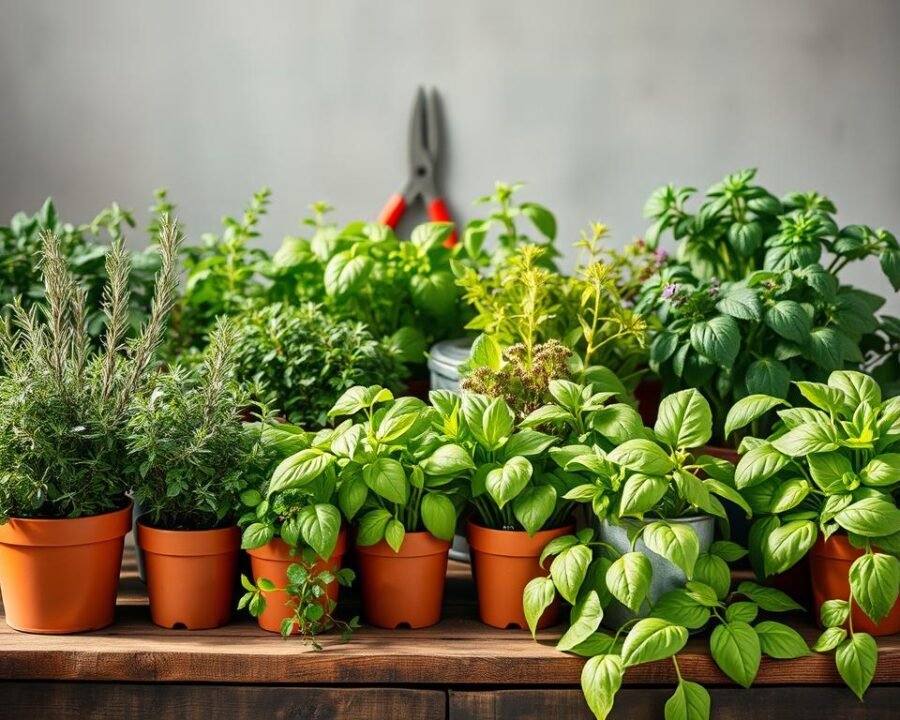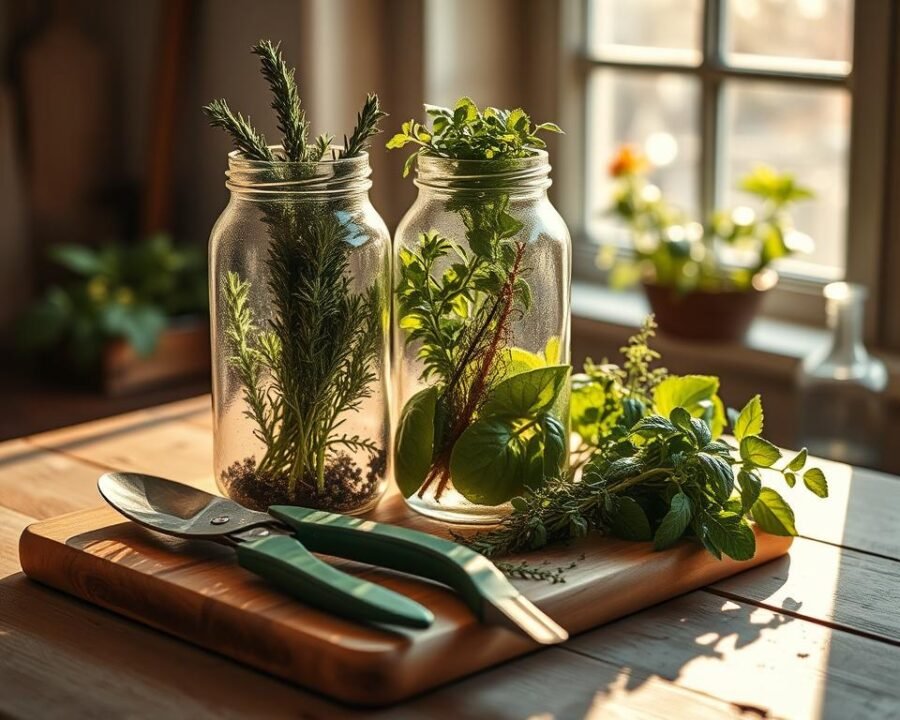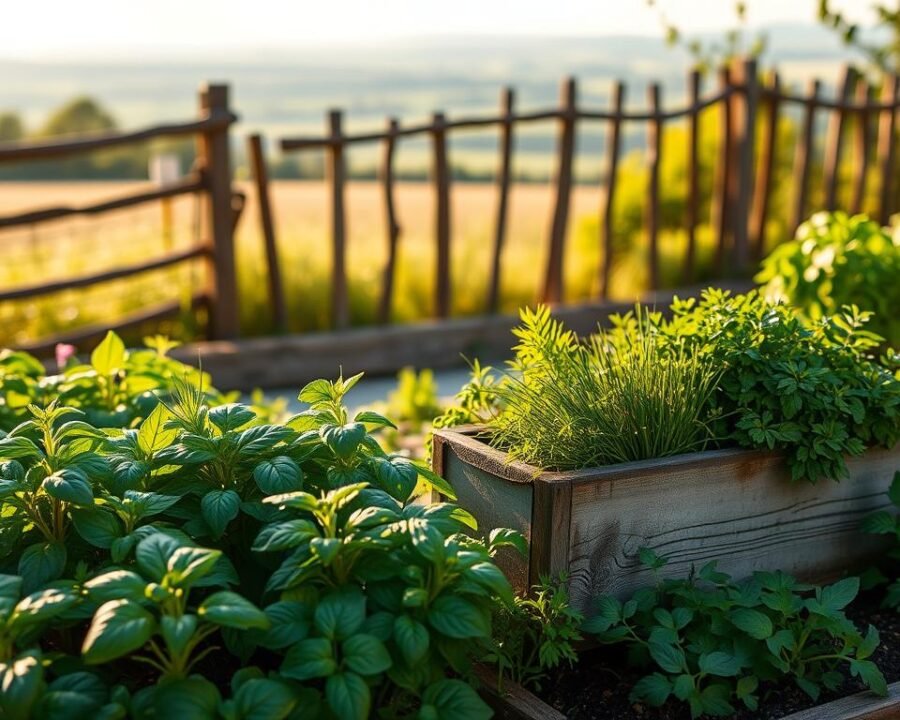There’s something magical about plucking fresh leaves straight from your own garden. Whether it’s basil for pasta or mint for tea, homegrown herbs elevate every dish with unmatched flavor. No more wilted supermarket bundles—just vibrant, aromatic greens grown with care.
More people are discovering the perks of cultivating their own herbs. It’s budget-friendly, rewarding, and surprisingly simple. Even beginners can succeed with the right guidance. Plus, skipping store-bought options means avoiding pesticides and long travel times that sap freshness.
Our guide breaks down the essentials—from choosing the right varieties to keeping them thriving year-round. Let’s turn your space into a lush, flavorful retreat.
Key Takeaways
- Homegrown herbs offer fresher, more potent flavors than store-bought options.
- They’re cost-effective and free from harmful chemicals.
- Even small spaces can support a thriving herb garden.
- Proper care ensures year-round harvests.
- Beginner-friendly methods make success achievable for all.
Why Grow Your Own Herbs?
Fresh herbs from your own space bring unmatched flavor and savings. Beyond taste, they pack more nutrients and cut grocery bills. Let’s explore why ditching store-bought options pays off.
Flavor and Nutrition You Can Trust
Homegrown greens outperform commercial ones in potency. A study found basil grown at home has 40% more essential oils than supermarket versions. These oils boost both taste and health benefits.
| Herb | Homegrown Nutrient Density | Store-Bought Equivalent |
|---|---|---|
| Basil | High (40% more oils) | Moderate (often faded) |
| Parsley | Rich in vitamin C | Lower after transport |
The Hidden Costs of Store-Bought
Big-box stores often treat plants with synthetic sprays to keep them shelf-ready. These chemicals fade once home, leaving weaklings. Over 80% fail within a month without constant care.
- Financial drain: A $3 seed packet grows 50+ plants.
- Waste: Plastic pots and transport emissions add up.
- Deception: Artificial vibrancy from fertilizers misleads buyers.
Local nurseries offer better starts. Their herb garden selections usually come with growth records and natural care tips.
Choosing the Right Herbs for Your Garden
Picking the perfect greens makes all the difference in your gardening success. With countless options, focus on varieties that match your climate, space, and experience level. Here’s how to narrow down the best herbs for your needs.

Beginner-Friendly Picks
New to gardening? Start with forgiving varieties like basil, rosemary, and dill. These adapt well to containers and require minimal fuss.
- Basil: Grows quickly from seeds; perfect for sunny windowsills.
- Rosemary: Drought-tolerant and thrives in zones 7–10.
- Dill: Fast-growing and attracts beneficial pollinators.
Annual vs. Perennial: What’s Best?
Understanding growth cycles helps plan long-term harvests. Annuals like cilantro complete their life cycle in one season, while perennials like thyme return yearly.
| Type | Examples | Lifespan |
|---|---|---|
| Annual | Basil, Cilantro, Parsley | 1 season |
| Perennial | Rosemary, Thyme, Oregano | 3+ years |
Finding Quality Seeds and Plants
Source seeds from trusted suppliers like Baker Creek or Botanical Interests. For nursery plants, ask growers:
- Were these grown organically?
- What’s the ideal sunlight/water routine?
- Any pest issues to watch for?
Avoid GMO options by checking for “non-GMO” labels. Test older seeds by sprouting them on damp paper towels before planting.
How to Grow Herb Plants Everyone Is Using: Step-by-Step
Transform your outdoor or indoor area into a fragrant oasis with these simple steps. Whether you’re working with a backyard plot or a windowsill, the right setup ensures healthy, aromatic greens.

Preparing Your Space: Sunlight and Soil Basics
Sunlight is non-negotiable. Most greens need 6+ hours daily. Use a sunlight calculator or track shadows to gauge exposure. South-facing spots are ideal for indoor setups.
For soil, blend 30% compost, 20% perlite, and 50% native dirt. This mix boosts drainage and nutrients. Test pH with vinegar (fizz = alkaline) or baking soda (fizz = acidic). Aim for 6.0–7.0 for most varieties.
In soggy areas, build raised beds. Layer gravel at the base, then add your soil mix. This prevents root rot and improves warmth.
Planting Seeds vs. Transplanting Seedlings
Seeds offer variety but need patience. Sow them at the right depth—basil at ¼ inch, parsley at ½ inch. Cover lightly and keep moist.
For quicker results, transplant nursery plants. Prevent shock by:
- Watering roots thoroughly before moving.
- Choosing cloudy days to reduce stress.
- Avoiding fertilizer for the first week.
Spacing and Grouping by Water Needs
Cluster thirstier greens like mint together. Drought-tolerant ones like rosemary thrive in separate zones. Here’s a quick guide:
| Water Needs | Examples | Tips |
|---|---|---|
| High | Basil, Parsley | Mulch to retain moisture |
| Low | Thyme, Oregano | Use sandy soil |
Companion planting boosts health. Pair basil with tomatoes or rosemary with cabbage to deter pests naturally.
Essential Care for Thriving Herbs
Keeping your greens vibrant requires mastering a few care basics. With the right balance of hydration, nutrients, and trimming, your garden will flourish season after season.

Watering Do’s and Don’ts
Overwatering kills plants faster than drought. Use the finger-test method: Insert a finger up to the second knuckle. If soil feels dry, it’s time to hydrate.
Morning watering reduces evaporation and fungal risks. Studies show evening sessions increase mildew by 25% in humid climates.
| Sign | Overwatered | Underwatered |
|---|---|---|
| Leaves | Yellow, limp | Crispy, curled |
| Soil | Soggy, smelly | Powdery, cracked |
| Growth | Stunted | Slow |
Fertilization Tips (and When to Skip It)
Most herbs thrive with minimal feeding. Perennial varieties like rosemary rarely need fertilizers. For annuals, try these organic boosts:
- Banana peel tea: Soak peels in water for 48 hours—rich in potassium.
- Eggshell powder: Crush dried shells for calcium-rich soil dusting.
Skip synthetic options during dormancy or extreme heat.
Pruning for Bushier Growth
Regular trimming prevents legginess. Snip just above leaf nodes to encourage branching. For continuous harvests:
- Pinch back basil every 2 weeks.
- Trim mint by ⅓ monthly to deter pests.
- Cut woody stems on thyme in early spring.
Dormant perennials benefit from a late-fall trim to conserve energy.
Growing Herbs in Containers
Urban gardeners rejoice: pots unlock fresh flavors anywhere. Whether you’re working with a fire escape or kitchen counter, the right setup turns tight spots into productive havens. Containers offer control over soil, sunlight, and moisture—key for fussy varieties.
Choosing the Right Pots and Soil
Size matters. Deep-rooted rosemary needs 12″+ pots, while shallow thyme thrives in 6″ depths. Match materials to your climate:
- Terracotta: Breathable but dries fast (ideal for humid areas).
- Fabric pots: Prevent root rot with air pruning.
- Stainless steel: Safely grow edibles without chemical leaching.
Skip garden soil—it compacts. Blend peat-free potting mix with perlite (3:1 ratio) for drainage and nutrients.
Drainage Tips to Avoid Over-Watering
Roots drown without escape routes. Ensure containers have holes, then layer:
- Coffee filters (blocks soil loss).
- ½” gravel or perlite (boosts aeration).
- Soil mix (leaves 1″ headspace).
Self-watering pots with wicks reduce guesswork. Add water only when the reservoir empties.
Best Herbs for Small Spaces
Compact varieties deliver big flavor in tiny footprints. Top picks include:
| Variety | Size | Special Perk |
|---|---|---|
| Greek oregano | 8″ tall | Drought-resistant |
| Lemon thyme | 6″ spread | Citrus fragrance |
| Spicy globe basil | 10″ bush | No pinching needed |
Maximize yields with tiered stands or wall-mounted pockets. Cluster pots by water needs to simplify care.
Propagating Herbs Like a Pro
Expanding your green collection doesn’t require buying new plants—just smart propagation techniques. With simple methods, you can clone favorites like rosemary or multiply perennial patches for years of harvests. Let’s explore three reliable ways to grow your garden for free.
Rooting Cuttings for Perfect Clones
Softwood stems from mint or sage root fastest. Follow the 4-node rule:
- Cut 6-inch stems below leaf nodes
- Strip lower leaves to expose 2 nodes
- Dip in rooting hormone (0.3% IBA for woody herbs)
- Plant in perlite-vermiculite mix
For woody types like rosemary, try air layering. Wrap moist sphagnum moss around scored branches until roots form.
Dividing Perennials for Instant Plants
Every 3-4 years, overgrown thyme or oregano benefits from splitting. Ideal time aligns with lunar cycles—divide during waxing moon phases for vigorous growth.
“Division tripled my Greek oregano in one season. Now I trade extras for rare varieties.”
Saving Seeds Like a Heritage Steward
Store seeds properly to maintain viability. Basil lasts 5 years in cool, dark conditions, while parsley fades after 12 months. Use silica packets in airtight jars to prevent mold.
| Herb | Viability | Storage Tip |
|---|---|---|
| Basil | 5 years | Label with harvest date |
| Parsley | 1 year | Freeze for longevity |
With these skills, any gardener can transform a single purchase into generations of plants. Start small—try rooting supermarket mint stems in water first.
Troubleshooting Common Herb Problems
Even the healthiest gardens face challenges—here’s how to spot and solve them. Early intervention saves plants and preserves harvests. We’ll cover pests, revival tactics, and seasonal tweaks to keep your greens thriving.
Pests and Diseases to Watch For
Aphids and spider mites love tender leaves. Spot them by curled foliage or sticky residue. Fight back naturally:
- Garlic oil spray: Blend 3 cloves with 1 cup water; strain and spray.
- Neem oil (diluted to 2%) disrupts pest life cycles.
- Companion plant with marigolds to deter beetles.
Fungal issues? UC Agricultural resources recommend copper fungicide for mildew. Always isolate infected plants first.
Reviving Struggling Plants
Yellow leaves often signal overwatering. Try this rescue plan:
- Trim dead growth to redirect energy.
- Repot with fresh soil if roots are soggy.
- Move to indirect light for recovery.
“My wilted basil bounced back in 10 days after a soil refresh and shade break.”
Seasonal Care Adjustments
Winter demands frost protection. Use cloches or row covers when temps drop below 40°F. Dormant herbs like rosemary need minimal water.
In spring, prune perennials before new growth starts. Refresh soil with compost to replenish nutrients. Adjust watering as daylight increases.
| Season | Key Task | Tool |
|---|---|---|
| Winter | Insulate roots | Straw mulch |
| Spring | Stimulate growth | Fish emulsion |
Harvesting and Preserving Your Herbs
The moment your greens reach peak flavor is magical. Proper techniques ensure their vibrant taste lasts beyond the summer season. Let’s explore how to capture that freshness for year-round use in your kitchen.
Timing and Techniques for Peak Flavor
Morning harvests deliver the highest essential oil content. Studies show oils concentrate after dew evaporates but before midday heat. For leafy varieties like basil, snip just above leaf nodes to encourage regrowth.
Moon phase harvesting isn’t just folklore. Research confirms:
- Waxing moon: Best for leaves (increased sap flow)
- Full moon: Ideal for flowers (lavender, chamomile)
- Waning moon: Prime time for roots (ginger, turmeric)
Preservation Showdown: Drying vs. Freezing
Each method affects flavor and nutrient retention differently. UV light studies reveal key differences:
| Method | Oil Retention | Best For |
|---|---|---|
| Air Drying | 60-70% | Woody stems (rosemary, thyme) |
| Dehydrator | 75-85% | Leafy types (basil, oregano) |
| Freezing | 90%+ | Tender leaves (chives, parsley) |
For freezing, blanching preserves color. Drop herbs in boiling water for:
- Basil: 5 seconds
- Parsley: 15 seconds
- Thyme: 3 seconds
Beyond the Spice Rack: Creative Applications
Your harvest can transform every corner of your place. Try these innovative ideas:
“Herb ice cubes revolutionized my cocktails. Freeze mint or lavender in coconut water for instant flavor bombs.”
More inspiration:
- Infused oils: Heat olive oil to 180°F with rosemary for 15 minutes (never room-temperature to avoid botulism)
- Potpourri: Combine dried lavender, rose petals, and cinnamon sticks
- Gifts: Bundle thyme sprigs with twine as aromatic bookmarks
With these methods, your kitchen becomes a hub of preserved garden goodness. Experiment to discover your favorite ways to savor the harvest.
Conclusion
Six weeks from now, you’ll snipping fresh leaves for dinner. Home cultivation transforms meals—and your connection to food. The journey from seed to harvest is as rewarding as the flavors.
Share extras with neighbors or trade cuttings. Communities thrive when gardeners swap tips and plants. For those ready to level up, hydroponic systems offer soil-free options.
Your starter kit checklist:
- Organic seeds or nursery plants
- Well-draining pots or garden space
- Basic tools (pruners, watering can)
Explore our guide to a year-round supply for deeper inspiration. Now, go plant something delicious.
